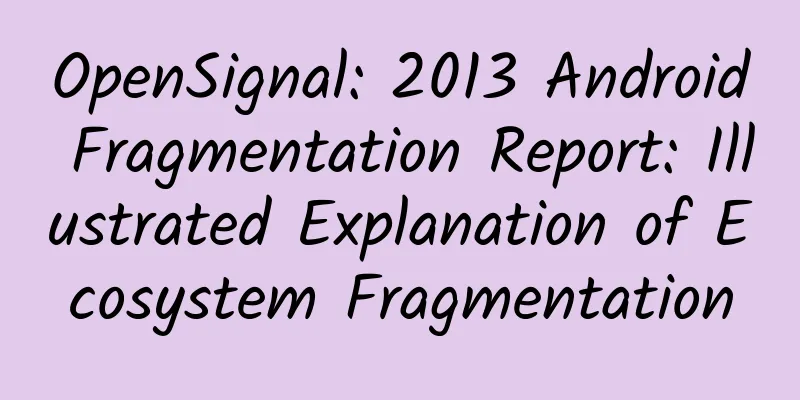OpenSignal: 2013 Android Fragmentation Report: Illustrated Explanation of Ecosystem Fragmentation

|
The fragmentation of Android has promoted the expansion of the ecosystem, but it has also brought disadvantages in terms of development difficulty. Startup OpenSignal recently conducted a data survey on 682,000 devices using its applications and issued a detailed visual report on the fragmentation of the Android ecosystem. Let’s first look at a simple set of data in the report: Problems caused by fragmentationThe differences in hardware configuration and screen size of Android devices is the first dimension of this ecosystem fragmentation. The second dimension of Android fragmentation is that the operating system itself has multiple versions, and at any time, any version has a certain number of users using it. The combined effect of these two dimensions is to greatly increase the difficulty and time cost of developing applications on Android devices (assuming that developers want to cover as many devices as possible to attract more users). The advantages of fragmentationApart from the above problems, fragmentation can also bring benefits to users and developers. Cheap Android devices mean that it can cover a wider range of users than iOS, so for developers, this is a larger potential audience (although the development difficulty is increased, but the temptation of the potential market cannot be resisted). For consumers, high fragmentation means that they can buy the mobile phone that suits their needs, and they have a lot of choices in terms of size, price and functions. Model fragmentationDistribution of Android devices using OpenSignal in July 2012 Distribution of Android devices using OpenSignal in July 2013 The number of device models on the market has grown from 3,997 to 11,868, almost three times the same period last year, so compare the two pictures to experience the difficulty of making apps compatible with so many devices. Brand fragmentationAndroid's fragmentation by brand is not much better than its distribution by model. The chart below effectively illustrates Samsung's dominance in this market, with a market share of 47.5%. Sony Ericsson is second with 6.5%, but this figure is less than 1/6 of the former. In the chart, different brands belonging to the same company are counted separately, such as Moto and Motorola, which are the names of HTC in different regions - but even if the data is combined, Motorola's final total share is only 4.2%, while HTC's is 3.9%. Fragmentation of the Android operating systemIn addition to hardware, the Android operating system itself is also highly fragmented. The white line shows the proportion of the latest generation of APIs over the entire time span. Comparison with iOS The fragmentation of Android is even more obvious when compared with iOS. The pie chart below illustrates the degree of fragmentation of the two operating systems at the API level. Screen size A perfect UI is crucial to the success of an app. Android has set two barriers for developers in this regard: first, major brands have built their own UI systems (Touchwhizz, HTC Sense...), which will change the default element display of Android. Second, no other platform can have such a wide range of device sizes as Android. The challenge of designing interfaces and structuring code for such a wide variety of screen sizes is obvious. Compared with iPod touch, iPhone and iPad only have four sizes. External articlesAndroid fragmentation is increasing as it expands to a wider geographical range, but developers should also be aware that fragmentation is not limited to devices and operating systems. Fragmentation of device usage scenarios should also be a factor that developers need to consider: some app features are applicable in some areas, but may not be used at all in other areas; network connectivity, such as adjusting your data transmission strategy in the app according to local WiFi coverage and network quality; and battery life, which is acceptable for users in developed areas for a day, but in less developed areas, it is a bit of a pitfall if you run out of power after using the device for a day. The performance of an app is not only affected by the device, but also by the user's region. In the above report, we can clearly see that Android fragmentation is increasing - more often we see it as a disadvantage rather than an advantage of Android. All developers know the problems caused by fragmentation better than we do, but it is unreasonable to blame them blindly. Apple is currently preparing to launch low-end devices, which will undoubtedly increase the degree of fragmentation in the ecosystem. The key to controlling this trend is to strike a balance between pleasing consumers and killing developers. Via: opensignal |
<<: Forbes Magazine: Smartphone makers face a "massacre"
>>: Are you getting the right vitamin D?
Recommend
Can I detect pregnancy in less than 30 days?
Some families who are preparing for pregnancy pay...
Diet to improve women's chances of pregnancy
In recent years, with the introduction of foreign...
How to delay uterine aging?
Everyone should know that not only the body ages,...
How many days will it take for menstruation to come if the endometrium is 0.8?
The thickness of the endometrium changes with the...
Chest tightness and shortness of breath during the change of seasons? Beware of the potential danger of respiratory allergies
Science expert: Chen Binbin Unit: Dashijie Commun...
What is the reason for menstrual difficulties?
Mature women will have menstruation every month. ...
Left side chest pain under armpit
The armpit area is quite special. Under normal ci...
What should women do if they have inflammation?
Due to the particularity of female reproductive o...
What causes chest pain before and after menstruation?
The menstrual period is over but the breasts stil...
Nipples of women who have given birth
Many women who have been pregnant and given birth...
Do you need to remove the skin when grilling pork belly? Why do you need to apply oil when grilling?
Barbecue charcoal is divided into wood charcoal a...
Can I drink green juice during menstruation?
You can drink green juice during menstruation. Wh...
What causes hemorrhoids in girls?
If you are embarrassed when talking about hemorrh...
My period falls off like meat
In life, female friends all know that normal mens...









